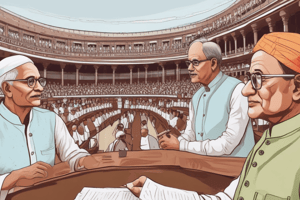Podcast
Questions and Answers
Who is typically responsible for administering government programs and policies in the executive branch?
Who is typically responsible for administering government programs and policies in the executive branch?
- Speaker of the House
- Chief Justice
- Prime Minister (correct)
- Secretary of State
Which branch of government is charged with interpreting and applying the law?
Which branch of government is charged with interpreting and applying the law?
- Judicial Branch (correct)
- Executive Branch
- Legislative Branch
- Ombudsman Branch
What is the primary role of the head of state in the executive branch?
What is the primary role of the head of state in the executive branch?
- Legislating new laws
- Representing the nation domestically (correct)
- Conducting trials
- Enforcing court decisions
Which branch of government includes officials such as cabinet members and vice presidents?
Which branch of government includes officials such as cabinet members and vice presidents?
What concept is essential for maintaining harmony among various levels of government?
What concept is essential for maintaining harmony among various levels of government?
In federalism, how are powers typically distributed between different levels of government?
In federalism, how are powers typically distributed between different levels of government?
What is the main purpose of the legislative branch in a government system?
What is the main purpose of the legislative branch in a government system?
How does federalism help in governance?
How does federalism help in governance?
What is the purpose of checks and balances in a government system?
What is the purpose of checks and balances in a government system?
Which branch of government interprets the law and resolves conflicts?
Which branch of government interprets the law and resolves conflicts?
Why are judges often appointed for life terms in many systems?
Why are judges often appointed for life terms in many systems?
What role does the upper house play in a bicameral legislature?
What role does the upper house play in a bicameral legislature?
Flashcards are hidden until you start studying
Study Notes
Government Institutions: A Comprehensive Overview
Government institutions are the fundamental structures of political authority, responsible for enforcing laws and carrying out public policies within a society. These institutions can operate on local, regional, national, or international levels, depending on the scope of the government in question. They can also vary widely across different countries due to their unique histories, cultures, and socio-political systems. This overview will focus on the main branches of government—the executive, judiciary, and legislature—as well as the concept of checks and balances and the role of federalism in maintaining harmony among various levels of government.
Executive Branch
The executive branch is usually headed by one person known as the head of state, who often holds the position of president, monarch, or prime minister. This individual is typically responsible for administering government programs and policies, acting as the face of the nation both domestically and internationally, and representing the country’s interests abroad. The executive branch also includes other high-ranking officials such as cabinet members and vice presidents.
Judicial Branch
The judiciary is charged with interpreting and applying the law. Its primary responsibility is to resolve legal disputes by determining whether actions taken by individuals, businesses, or governments conform to existing statutes and constitutional provisions. In many systems, the highest court in the land serves as the ultimate arbiter of what the law means and how it applies. Judges are often appointed for life terms to ensure their independence from partisan pressures.
Legislative Branch
This branch consists of elected representatives who formulate and pass new laws, approve budgets, and oversee the activities of the executive branch. Depending on the country, legislatures may be unicameral (with one chamber) or bicameral (with two chambers). One common distinction is between upper and lower houses; for example, the U.S. Congress has the Senate (upper house) and House of Representatives (lower house).
Checks and Balances
Checks and balances refer to the system by which each branch of government exercises some control over the others. This ensures that no single entity becomes too powerful, thus protecting against abuses of power. For instance, if the executive branch wants to levy taxes without congressional approval, it must go through the judiciary to determine its legality. Similarly, courts cannot invalidate laws passed by Congress unless they violate the Constitution. This system helps maintain a balance among the three branches, preventing any one institution from dominating another.
Federalism
Federalism is the organization of government into multiple layers, with powers divided among distinct units—such as states, provinces, cantons, or regions—and a central authority. It allows governance responsibilities to be shared between the national level and smaller, more localized entities. Because larger governments have access to wider resources like tax revenue, they can handle tasks beyond the reach of smaller units. However, federalism also provides autonomy to these smaller units, allowing them to tailor policies to meet local needs.
In conclusion, understanding the complexities of government institutions—from the executive powers that drive change to the checks and balances that prevent abuse of those powers, and the roles played by the judiciary in interpreting the law and resolving conflicts—is crucial for appreciating how a democracy functions effectively. Additionally, recognizing the importance of federalism and the division of powers throughout various levels of government can help us understand how decisions are made and why our societies look the way they do today.
Studying That Suits You
Use AI to generate personalized quizzes and flashcards to suit your learning preferences.




